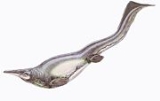
Plotosaurus
Encyclopedia
Plotosaurus is an extinct genus of mosasaur
from the Upper Cretaceous
(Maastrichtian
) of Fresno County, California
. Originally named Kolposaurus
(meaning "bay lizard") by Berkeley paleontologist Charles Lewis Camp
in 1942, it was changed to Plotosaurus in 1951 when Camp discovered the name had already been assigned to a type of nothosaur
.
Based on cladistic analysis, plotosaurs are considered to be the most derived branch of mosasaur evolution.
).
A second species, P. tuckeri, was also found in 1937 by Frank Paiva and Professor William M. Tucker. Although, not quite as advanced in aquatic adaptations as P. bennisoni it was about 40% larger, reaching lengths of around 13 metres (42.7 ft) . However, a recent analysis by Lindgren, Caldwell and Jagt (2008) considers P. tuckeri to be a junior synonym.
Mosasaur
Mosasaurs are large extinct marine lizards. The first fossil remains were discovered in a limestone quarry at Maastricht on the Meuse in 1764...
from the Upper Cretaceous
Cretaceous
The Cretaceous , derived from the Latin "creta" , usually abbreviated K for its German translation Kreide , is a geologic period and system from circa to million years ago. In the geologic timescale, the Cretaceous follows the Jurassic period and is followed by the Paleogene period of the...
(Maastrichtian
Maastrichtian
The Maastrichtian is, in the ICS' geologic timescale, the latest age or upper stage of the Late Cretaceous epoch or Upper Cretaceous series, the Cretaceous period or system, and of the Mesozoic era or erathem. It spanned from 70.6 ± 0.6 Ma to 65.5 ± 0.3 Ma...
) of Fresno County, California
California
California is a state located on the West Coast of the United States. It is by far the most populous U.S. state, and the third-largest by land area...
. Originally named Kolposaurus
Kolposaurus
Kolposaurus is a junior synonym of both:* Nothosaurus and* Plotosaurus...
(meaning "bay lizard") by Berkeley paleontologist Charles Lewis Camp
Charles Lewis Camp
Charles Lewis Camp was a notable palaeontologist and zoologist, working from the University of California, Berkeley...
in 1942, it was changed to Plotosaurus in 1951 when Camp discovered the name had already been assigned to a type of nothosaur
Nothosaur
Nothosaurs were Triassic marine sauropterygian reptiles that may have lived like seals of today, catching food in water but coming ashore on rocks and beaches. They averaged about in length, with a long body and tail. The feet were paddle-like, and are known to have been webbed in life, to help...
.
Description
Plotosaurs possessed several adaptations to marine life not seen in other mosasaurs. Compared with their relatives, they had narrower flippers, large tail fins and a streamlined fusiform body shape. These features probably enabled them to be faster swimmers than most other mosasaurs . They also had relatively large eyes for keen eyesight, and impressions found with their fossils suggest that they had scaly skin.Based on cladistic analysis, plotosaurs are considered to be the most derived branch of mosasaur evolution.
Species
The type species, P. bennisoni, was named for Allan Bennison, a fossil hunter who discovered the first remains in 1937. It was around 9 metres (29.5 ft) long, and was the first known mosasaur from California (a year previously, Bennison had also discovered the state's first dinosaur, SaurolophusSaurolophus
Saurolophus is a genus of large hadrosaurine duckbill that lived about 69.5-68.5 million years ago, in the Late Cretaceous of North America and Asia; it is one of the few genera of dinosaurs known from multiple continents. It is distinguished by a spike-like crest which projects up and back...
).
A second species, P. tuckeri, was also found in 1937 by Frank Paiva and Professor William M. Tucker. Although, not quite as advanced in aquatic adaptations as P. bennisoni it was about 40% larger, reaching lengths of around 13 metres (42.7 ft) . However, a recent analysis by Lindgren, Caldwell and Jagt (2008) considers P. tuckeri to be a junior synonym.
External links
- Mosasauridae Translation and Pronunciation Guide http://www.dinosauria.com/dml/names/mosa.html#P
- Natural History Museum of Los Angeles County http://www.nhm.org/journey/prehist/marine/plotosaurus.html
- UCMP Paleontology Portal http://www.paleoportal.org/index.php?globalnav=fossil_gallery§ionnav=detail&submission_id=687&taxon_id=&state_id=&period_id=18&assemblage_id=&last_section=search

